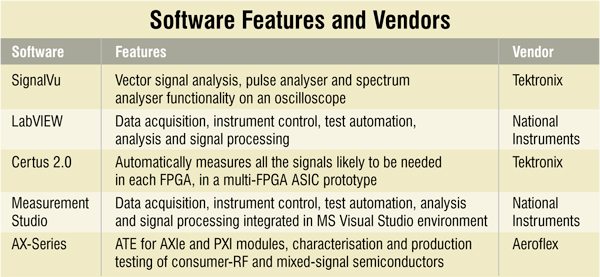The challenges faced
A software-centric ecosystem can be successful only if the members of the ecosystem are capable of developing good-quality IP, and are willing to share their IP with their peers. To ensure good-quality-content creation within the community, it becomes imperative for the T&M players to train community members on their hardware and software platforms, and educate them about the best practices and conventions to follow while writing add-ons, toolkits, etc. Since an ecosystem adds value to a T&M player’s proposition to the market, and improves its customers’ productivity, it is important for that player to facilitate such training. For instance, free webcasts, tutorials, best practices documents, self-paced training, etc, are available to educate and encourage community members to develop and share IP, and increase add-ons to its software and hardware portfolio.
Sambit Panigrahi, Texas Instruments, adds, “We were once faced with the unenviable task of having to develop a modular test solution that was abstract, scalable and easy to use, while supporting test sequencing across hundreds of power management ICs (PMIC) and interacting with multiple instruments, evaluation modules and source measure units (SMUs). Luckily, we were able to utilise LabVIEW to build a flexible and modular automated test solution that could test several PMICs with different requirements, communications buses and protocols.”
An ideal scenario for T&M players would be that community members share their IP free of cost with everyone. This, however, is not possible in most cases, and T&M players have to deal with community members whose employers do not allow them to share their IP, and community members who do not want to share their IP for free. T&M players, therefore, have to come up with innovative ways to incentivise content sharing in the ecosystem.
T&M players have to ensure that their hardware and software platforms are standardised, open and customisable enough for the ecosystem to develop. At the same time, they have to ensure the quality of their products and their compatibility with these add-ons. Active industry groups such as the IVI Foundation, PXI Systems Alliance and LXI Consortium are bringing industry players together by standardising the hardware platforms. By developing a common means of communicating to similar instruments across multiple vendors at the application programming interface level, the IVI Foundation has reduced the learning curve for users and the development cycle for vendors. This has opened the door for third parties to create drivers, aggregation websites to house them, and abstraction layers to be created on top of them—essentially helping the ecosystem grow even further.

Naresh Kumar, general manager, Application Engineering Organisation, Agilent Technologies India, says, “Some of the challenges faced while developing a suitable ecosystem for the products include interworking with standard software development platforms and languages such as C, C++, C#, VB, VB .NET, VEE or LabVIEW, along with test automation-specific languages like Agilent’s VEE Pro and Test Exec SL, besides developing instrument drivers for multiple platforms (IVI, MATLAB, LabVIEW). Another interesting challenge is with regard to integrating reporting features for generating test reports into the test automation software.”
The future of software-centric ecosystems
There should be no doubt about the fact that software-centric solutions are here to stay. Without such an ecosystem, many viable open platforms have struggled. The xTCA platforms had seen adoption in telecommunication infrastructures and interest from the high-energy physics community, but they failed to develop a strong ecosystem in automated testing. The multiple form factor, communication bus and software options presented by the platform have delayed or complicated adoption by leading vendors. While efforts to rein in those options and improve them for automated testing are under way at the AXIe Consortium, success or failure will be dictated by the use of a software-centric ecosystem.
Over the next three to five years, automated test systems will become more software-centric and ecosystems will have more of an impact on the value users derive from these platforms. In the past, your test system was only as valuable as the investment of time and money that you made in it. Going forward, your system will benefit from the entire community of third-party suppliers, integrators, consultants, and derived standards supporting the software ecosystem at its core. This is a crucial element in meeting the demands of next-generation device testing. Software vendors taking greater advantage of their ecosystems and leveraging commercialisation models for third-party IP will have a transformative effect on the test and measurement industry.
Naresh Kumar adds, “The trend is moving towards an emphasis on the seamless integration of T&M-specific software with standard software languages or platforms, thereby providing an opportunity for easy integration of software and hardware. In the near future, there will still be a need for further development in this domain due to the requirement for ease of automation in the manufacturing and design domains, which will drive developments in the software ecosystems enabled by T&M players like Agilent.”
The author is a tech correspondent at EFY Bengaluru






